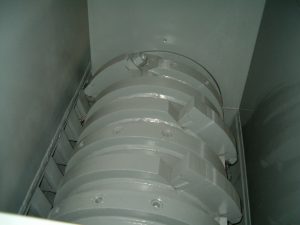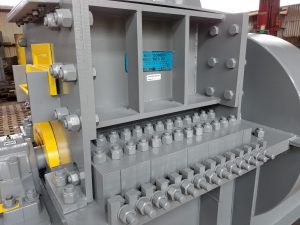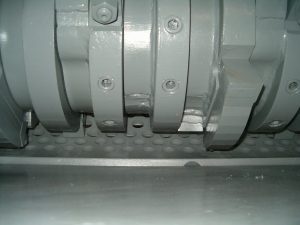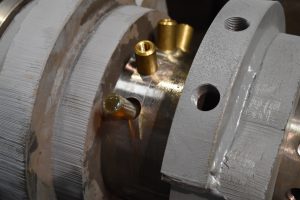Punch & Die Hogs – T3 Cut
A Voracious Appetite for Reducing Waste
These days it’s called going green. We’ve always referred to it as pulling money out of the trashcan. Waste not; want not – it’s just common sense. Size reduction provides a means of utilizing many types of dry solids that can be reclaimed, recycled or burned as fuel.
In 1946, W.T.S. Montgomery invented and patented the Punch and Die Hog as a better way to extract higher value out of a variety of waste materials. Originally designed to convert wood and bark scrap into more efficient boiler fuel, Montgomery Hog applications now include mulch, particleboard, charcoal, fuel pellets, bull screen rejects, veneer, pallets, corrugated paper, gypsum rock, oil shale, industrial trash, roofing shingles, polyurethane scrap and many forms of plastics.
Across a broad spectrum of applications, it’s hard to beat the proven results of Montgomery.
The Punch and Die System
An Efficient Two-Stage Grind Using Only One Machine
 The Punch and Die System provides a two-stage grind in a single machine. The first grind occurs when a set of rotating teeth (hammers) punch material through a series rectangular pockets formed by stationary dies (anvils).
The Punch and Die System provides a two-stage grind in a single machine. The first grind occurs when a set of rotating teeth (hammers) punch material through a series rectangular pockets formed by stationary dies (anvils).
The teeth are secured to a spinning rotor assembly. The anvils are fixed to the side of the machine. The anvils can be adjusted when the machine is not running in order to set the proper tooth-anvil clearance for optimum hogging.

A pattern of high and low teeth with large and small anvils keeps material moving with nowhere to hide, allowing the hog to rapidly process material with relentless efficiency. The T3 cut employs two inch wide cutting teeth grinding against two inch wide stationary anvils.
 The second grind occurs after the material has been processed past the anvils and directed downward across a curved sizing screen. The screen openings can be made of various shapes and sizes to customize the end product. Steel bars (baffles) are typically added on larger sized holes to control the length of material that is allowed to get through.
The second grind occurs after the material has been processed past the anvils and directed downward across a curved sizing screen. The screen openings can be made of various shapes and sizes to customize the end product. Steel bars (baffles) are typically added on larger sized holes to control the length of material that is allowed to get through.
Baffles can be applied in varying configurations in order to optimize throughput while avoiding unwanted sticks and slivers that can clog pipes, jam screw conveyors, reduce boiler efficiency or degrade the salability of mulch. The screens are designed for easy removal and replacement.
Tramp Metal Protection
Internal Shear Pins
In addition to assuring longer life, the rugged construction of a Montgomery Hog allows it to process light metal (1/4 inch and thinner), nails, small bolts and steel strapping. Should something more serious come between the teeth and anvils or the teeth and screen, Internal Shear Pins are used to protect the hog and mitigate the potential for damage.
 Each breaker ring along the rotor assembly is individually secured to the solid steel shaft and held in position by three bronze shear pins. The shearing strength of these pins is sufficient to carry loads encountered during normal operation but will shear if heavy tramp metal enters the hog, affording some independence of the ring to spin on the shaft.
Each breaker ring along the rotor assembly is individually secured to the solid steel shaft and held in position by three bronze shear pins. The shearing strength of these pins is sufficient to carry loads encountered during normal operation but will shear if heavy tramp metal enters the hog, affording some independence of the ring to spin on the shaft.
A plastic cylinder of oil is inserted in the first hole behind the tooth to provide temporary lubrication if shear occurs. New shear pins and oil cylinders can be installed in minutes so that the hog can resume normal operation.